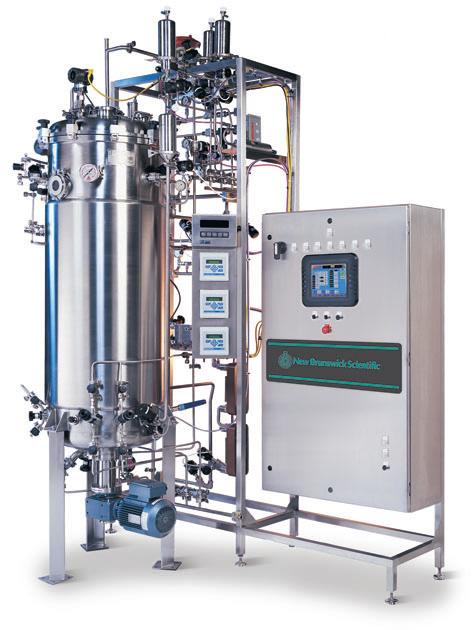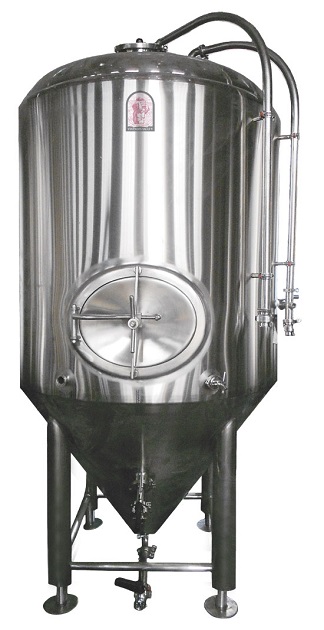Continuous stirred tank reactors ( CSTR ) are the most basic of the continuous reactors used in chemical processes. The CSTR below is a half-pipe coil jacketed reactor.
(Copyright Central Fabricators, Cincinnati, OH)
General Information
Continuous stirred-tank reactors (CSTRs) are open systems, where the material is free to enter or exit the system, that operate on a steady-state basis, where the conditions in the reactor don’t change with time. Reactants are continuously introduced into the reactor, while products are continuously removed.
CSTRs are very well mixed, so the contents have relatively uniform properties such as temperature, density, etc. throughout. Also, conditions in the reactor’s exit stream are the same as those inside the tank. Pictured below is a CSTR that has yet to be fitted with a stirring system.
(Copyright American Alloy Fabricators, Inc., Norristown, PA)
Systems connecting several CSTRs are used when the reaction is too slow. Multiple CSTRs can also be used when two immiscible liquids or viscous liquids are present and require a high agitation rate.
The movie below shows the operation of a CSTR. Reactants are fed continuously into the reactor through ports at the top. The contents of the tank are well mixed by the unit’s stirring device. Products are removed continuously.
Equipment Design
CSTRs consist of a tank, usually of constant volume, and a stirring system to mix reactants together. Feed and exit pipes are present to introduce reactants and remove products. Pictured below is a CSTR that has had a portion of its side removed to show the interior.
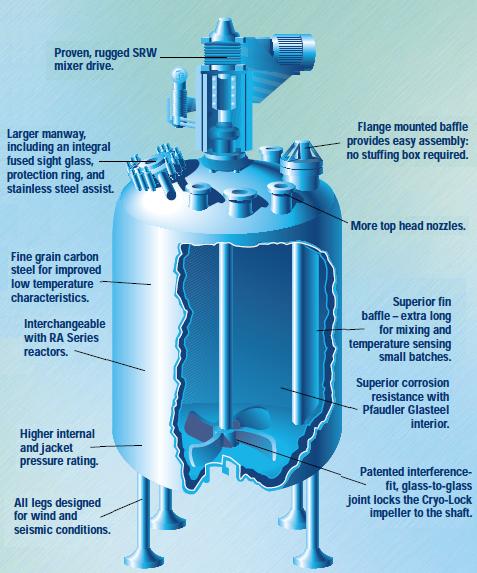
Stirring blades, also called agitators, are used to mix the reactants. Below are pictures of various agitators that could be used inside a CSTR.

A CSTR can also function as a loop reactor when a heated, pressurized fluid is injected into the system to facilitate the stirring. This allows for higher heat and mass transfer rates while simplifying maintenance because there is no agitator.
The picture below is of a cell culture reactor. An initial amount of cells are placed in the fibrous-bed basket. A nutrient-rich medium is continuously fed into the reactor, and products are harvested. As the cells grow, they produce by-products, which are continuously removed from the reactor. The reactor below uses a pitched-blade impeller to continuously mix the reactants.
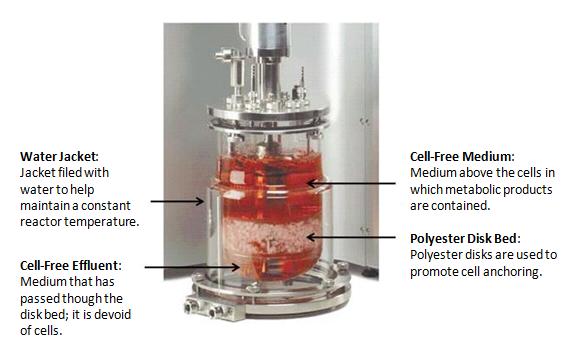
Usage Examples
Continuous stirred-tank reactors are most commonly used in industrial processing, primarily in homogeneous liquid-phase flow reactions, where constant agitation is required. They may be used by themselves, in series, or in a battery. CSTRs are also used in the pharmaceutical industry as loop reactors.
A dimple jacketed pressure vessel is shown in the picture on the left, and a half-pipe coil jacket reactor is on the right.
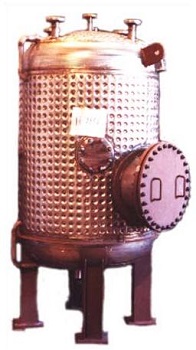
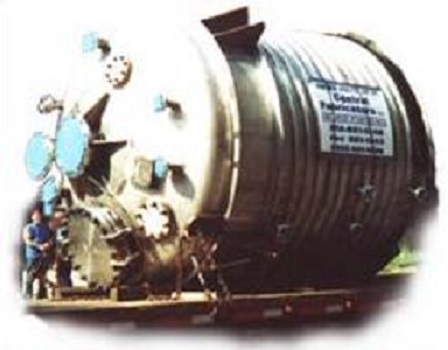
(Copyright Central Fabricators, Cincinnati, OH)
As mentioned earlier, CSTRs are often used in biological processes The CSTR shown below can be used for high-density animal cell culture in research or production. The vessels used are for single use.
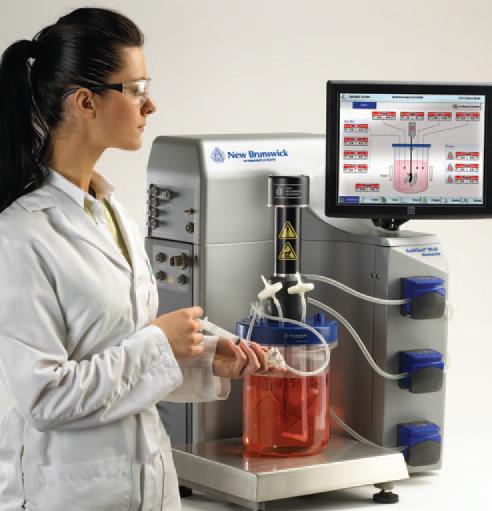
Fermenters are another application of CSTRs that involve the use of a biological catalyst to generate products. In a fermenter, microbes catalyze a reaction that breaks down much larger molecules into smaller molecules such as ethanol, methanol, or other hydrocarbons. Vapor product can be removed from the top of a unit without separation, or liquid product can be removed from the bottom, filtering out and recycling the microbial media.
Fermenters are used in many industries such as brewing, pharmaceuticals, wastewater treatment, and hydrocarbon processing. The pilot-plant fermenter on the left has a 500L capacity, while the production scale fermenter on the right has a 12,000L capacity. You can consult the Bioreactors page for more information on fermenters.
Advantages
- Good temperature control is easily maintained
- Cheap to construct
- Reactor has large heat capacity
- Interior of reactor is easily accessed
Disadvantages
- Conversion of reactant to product per volume of reactor is small compared to other flow reactors
- Deadzones, where no mixing occurs, can develop
- Reactants can bypass if outlet placed improperly
Acknowledgments
- American Alloy Fabricators, Inc., Norristown, PA
- Central Fabricators, Cincinnati, OH
- DCI, Inc., St. Cloud, MN
- New Brunswick Scientific, Edison, NJ; now part of Eppendorf
- Pfaudler, Inc., Rochester, NY
- Vintner’s Vault, Paso Robles, CA
References
- “Chemical Reactors.” CIEC Promoting Science at the University of York, York, UK. University of York, 18 Mar. 2013. Web. http://www.essentialchemicalindustry.org
- Fogler, Scott H. Elements of Chemical Reaction Engineering. 5th ed. Englewood Cliffs, NJ: Prentice-Hall, 2016. Print.
- Hill, Charles G., Jr. An Introduction to Chemical Engineering Kinetics and Reactor Design. New York: John Wiley & Sons, Inc. 1977. Print.
- Lozowski, Dorothy, Gregory, Jim, Green, Bob, Courtemanche, Nicolle, Kehn, Richard, Chemical Engineering. Rockford, MD: Access Intelligence, Mar. 2014. Print.
- Perry, Robert H., and Don W. Green. Perry’s Chemical Engineers’ Handbook. 7th ed. New York: McGraw-Hill Inc., 1997: 7-17 – 7-19. Print.
- Trambouze, Pierre, Van Landeghem, Hugo, and Wauquier, Jean-Pierre. Chemical Reactors. Houston: Gulf Publishing Company, 1988. Print.
- Walas, Stanley M. Chemical Process Equipment: Selection and Design. Boston: Butterworth-Heinemann, 1990. Print.
- Walas, Stanley M. Reaction Kinetics for Chemical Engineers. New York: McGraw-Hill Inc., 1959. Print.
Developers
- Sam Catalano
- Steve Wesorick
- Kelsey Kaplan
- Thomas Plegue
- Joel Holland




